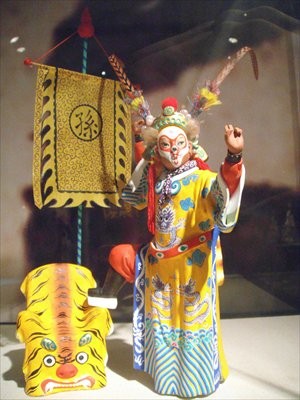
When most Chinese children are asked what toys they want, toys from other countries top the list. Whether it's a PSP (Playstation Portable) or an iPad, Lego sets or Barbie dolls, most toys aren't particularly reflective of Chinese culture.
One could be forgiven for assuming China doesn't have much of a toy culture, however a new exhibition in Beijing hopes to lay these misconceptions to rest. The exhibition, entitled "Great Success comes from Playing: Folk Toy Collections from the National Art Museum of China," opened on Wednesday to coincide with International Children's Day. It includes a stunning array of Chinese toys, some of which have been beloved playthings for thousands of years.
The museum started collecting folk toys in the 1980s and the collection covers toys from across the country, with works made by masters as well as anonymous toy-makers.
Many of the toys represent particular aspects of Chinese mythology and symbolism.
The exhibition is divided into three sections: Well-Wishing, Intellectual Development and Edutainment. The Well-Wishing section mainly showcases toys for infants and toddlers, which are mostly cloth tigers filled with cotton. The name refers to the traditional belief that tigers can drive out evil spirits from homes and bring good luck. Parents often hope that their children will be as strong as a tiger, thus cloth tigers are often given to babies.
"I had a cloth tiger when I was a boy. It was handmade, soft and amazingly beautiful," said Xu Tian, a 34-year-old computer engineer and father. He is fascinated by the toys. "They [the toys] also represent the hopes of the parents, which is something you can not say about Hello Kitty. I'll buy a cloth tiger for my girl, as they're not just a nostalgic toy but also a part of Chinese culture," he said.
The Intellectual Development section focuses on interactive toys, with science playing a key role. One example can be seen in the movements of the dancing "bristle-dolls." Modeled on the masks of the Peking Opera, the bristle dolls have clay cores and boar bristles glued to their bases. These dolls are put on a metal plate which when struck with a stick causes the dolls to dance. "This is the only toy that 'performs,'" said Bai Dacheng, art master and China's only bristle-doll maker. "The dolls are just like performers on the stage and the sound from the plate is just like Peking Opera music," he said.
The Edutainment section features toys that incorporate traditional stories. Most of the toys are dolls that represent characters from folk tales or traditional operas.
Usually these toys represent traditional hero figures in order to teach children moral principles. Zhan Xiufen, Chief Manager of a culture industry company in Taiwan, said these toys have a "stunning colorful beauty."
"The northern style, is less restricted, seen in the imbalanced limbs and body sizes," said Zhan, "This gives these toys a Picasso-style abstract beauty, which I believe would be universally popular on the global stage."
When: Until September 3
Where: 5th floor, National Art Museum of China, 1 Wusi Dajie, Dongcheng district
Tickets: Free
Contact: 6400-6326

Copyright ©1999-2011 Chinanews.com. All rights reserved.
Reproduction in whole or in part without permission is prohibited.